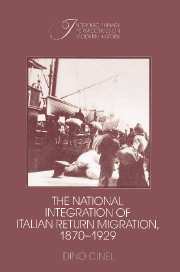Book contents
- Frontmatter
- Contents
- Acknowledgments
- Introduction: Emigration and the process of national integration
- 1 The difficult task of national integration
- 2 A blueprint for change
- 3 The southern ethos
- 4 The national debate
- 5 Return migration
- 6 American remittances
- 7 Investing American savings
- 8 Regional differences
- 9 Return and retirement
- Conclusion: National integration and return migration
- Notes
- Index
Introduction: Emigration and the process of national integration
Published online by Cambridge University Press: 03 December 2009
- Frontmatter
- Contents
- Acknowledgments
- Introduction: Emigration and the process of national integration
- 1 The difficult task of national integration
- 2 A blueprint for change
- 3 The southern ethos
- 4 The national debate
- 5 Return migration
- 6 American remittances
- 7 Investing American savings
- 8 Regional differences
- 9 Return and retirement
- Conclusion: National integration and return migration
- Notes
- Index
Summary
Return migration is today a worldwide phenomenon. According to an estimate by the United Nations, as many as one hundred million people engage every year in seasonal migrations. The phenomenon affects virtually every nation that has significant emigration or immigration. In Europe, for instance, return migration is today a mass phenomenon in Italy, Spain, Portugal, and Spain. For several decades West Germany, France, Switzerland, and the Scandinavian countries have been nations of immigration. In absolute numbers, Italy is the largest participant in the phenomenon. From 1945 to 1983 about eight million Italians left the country and five million returned. Within Italy, the south and the Veneto in the northeast are the regions most deeply affected by the phenomenon. Germany and Switzerland have been the preferred destinations of Italians.
Individuals engaging in temporary international emigrations fall into two categories: seasonal migrants and temporary emigrants. Seasonal migrants relocate abroad for one season and return home at the end of it. In most cases the same individuals engage in seasonal migrations year after year. Immigration policies of countries of immigration are mostly responsible for seasonal migrations. For instance, Switzerland attracts tens of thousands of foreign workers every year and forces them to leave at the end of each season, the intention being to prevent these immigrants from becoming permanent residents of the Confederacy. More rarely, seasonal migrations are the result of personal choices by individuals unwilling to uproot their families from the home environment. Temporary emigrants, on the other hand, are individuals seeking employment in foreign countries for a number of years, then returning to home communities with savings.
- Type
- Chapter
- Information
- Publisher: Cambridge University PressPrint publication year: 1991

